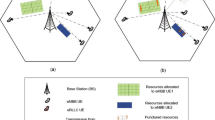Abstract
In this project, the main focus is to enhance the existing power control algorithm that is applied in a single cell of CDMA network. Nash algorithm is selected and is further improved with modification of its cost function with a value as power of target SINR, which to reduce the SINR error at first iteration, so as to increase the rate of convergence effectively. Decision of a value is important to ensure the SINR error is reduced at first iteration. The uniqueness and algorithm convergence of enhanced cost function is proven with certain conditions requirements. Therefore, enhanced Nash algorithm (ENA) is proposed which only applicable in first iteration of power control method. The rest of iterations are applied by Nash algorithm due to its better convergence to target SINR. After simulations, with consideration of Rayleigh and Rician fading channels, a significant increase in rate of convergence while maintaining the SINR with error less than 0.01 is shown. The transmitted power is lower in some scenarios, or with very slight reduction less than 0.5%. The SINR error at first iteration is reduced about 20% more by using ENA. In overall, ENA has better performance than the existing Nash algorithm in terms of transmitted power and rate of convergence, without compromising SINR.







Similar content being viewed by others
References
Hossain, M. N., & Ara, I. (2013). SIR-based power control algorithms in CDMA networks. Global Journal of Computer Science and Technology, 13(10), 40–45.
Othman, I. (2013). Uplink channel power control improvement in DS-CDMA system using channel predictions (Doctoral dissertation, Universiti Tun Hussein Onn Malaysia).
Goodman, D., & Mandayam, N. (2000). Power control for wireless data. IEEE Personal Communications Magazine, 7, 48–54.
Wang, L., Tsimenidis, C. C., & Adams, A. E. (2006). Adaptive power control using channel state information gradient for mobile radio systems. In 20th International conference on advanced information networking and applications (AINA’06), Vienna (Vol. 1, pp. 915–919).
Zander, J. (1992). Performance of optimum transmitter power control in cellular radio systems. IEEE Transactions on Vehicular Technology, 41(1), 57–62.
Grandhi, S. A., & Zander, J. (1994). Constrained power control in cellular radio systems. In Proceedings of IEEE 44th vehicular technology conference (Vol. 2, pp. 824–828).
Foschini, G., & Miljanic, Z. (1993). A simple distributed autonomous power algorithm and its convergence. IEEE Transactions on Vehicular Technology, 42, 641–646.
Yates, R. D. (1995). A framework for uplink power control in cellular radio systems. IEEE Journal on Selected Areas in Communications, 13(7), 1341–1347.
Aein, J. M. (1973). Power balancing in systems employing frequency reuse. COMSAT Technical Review, 3(2), 277–299.
Meyerhoff, H. J. (1974). Method for computing the optimum power balance in multibeam satellites. COMSAT Technical Review, 4(1), 139–146.
Wang, H., Huang, A., Hu, R., & Gu, W. (2000). Balanced distributed power control. In Proceedings of 11th IEEE international symposium on personal, indoor and mobile radio communications (Vol. 2, pp. 1415–1419).
Sung, C. W., & Wong, W. S. (2000). Performance of a cooperative algorithm for power control in cellular systems with time-varying link gain matrix. Wireless Networks, 6, 429–439.
Alpcan, T., Basar, T., Srikant, R., & Altman, E. (2002). CDMA uplink power control as a noncooperative game. In Proceedings of the 40th IEEE conference on decision and control (Cat. No.01CH37228) (Vol. 1, pp. 197–202).
Chisci, L., Fantacci, R., Mucchi, L., & Pecorella, T. (2008). A queue-based approach to power control in wireless communication networks. IEEE Transactions on Wireless Communications, 7(1), 128–134.
Musku, M. R., Chronopoulos, A. T., Popescu, D. C., & Stefanescu, A. (2010). A game-theoretic approach to joint rate and power control for uplink CDMA communications. IEEE Transactions on Communications, 58(3), 923–932.
Koskie, S., & Gajic, Z. (2005). A Nash game algorithm for SIR-based power control in 3G wireless CDMA networks. IEEE/ACM Transactions on Networking, 13(5), 1017–1026.
Lu, K., Zhang, L., & Yang, J. (2012). An efficient SIR-first adaptive power control method in cognitive radio network. In 2012 IEEE Global High Tech Congress on electronics, Shenzhen (pp. 91–94).
Hayajneh, M., Khalil, I., & Awad, M. (2009). Non-cooperative uplink power control game for CDMA wireless communications systems. In IEEE Symposium on computers and communications, Sousse (pp. 587–592).
Pasandshanjani, E., Khalaj, B. H., & Moghaddam, M. S. (2011). A new cost function for game theoretic SIR-based power control algorithms. In 7th International wireless communications and mobile computing conference (pp. 1147–1151).
Zhang, L., Zhang, S., Wu, L., Liu, Y., & Zhao, C. (2009). A Nash game algorithm for distributive power control with faster convergence in cognitive radio. In 9th International symposium on communications and information technology, Icheon (pp. 93–96).
Chen, Y. (2015). The research on non-cooperative power control game algorithm for cognitive radio. In 6th IEEE International conference on software engineering and service science (ICSESS) (pp. 633–636).
Duffy, J. (2015). Game theory and Nash equilibrium. Thunder Bay: Lakehead University Publishing.
Acknowledgements
This research is supported by Center for Research and Innovation (PPPI) and Faculty of Engineering, Universiti Malaysia Sabah (UMS).
Author information
Authors and Affiliations
Corresponding author
Additional information
Publisher's Note
Springer Nature remains neutral with regard to jurisdictional claims in published maps and institutional affiliations.
Rights and permissions
About this article
Cite this article
Farzamnia, A., Yew, E.S. & Moung, E.G. A Non-cooperative Uplink Power Control for CDMA Wireless Communication System. Wireless Pers Commun 114, 1249–1265 (2020). https://doi.org/10.1007/s11277-020-07419-7
Published:
Issue Date:
DOI: https://doi.org/10.1007/s11277-020-07419-7




